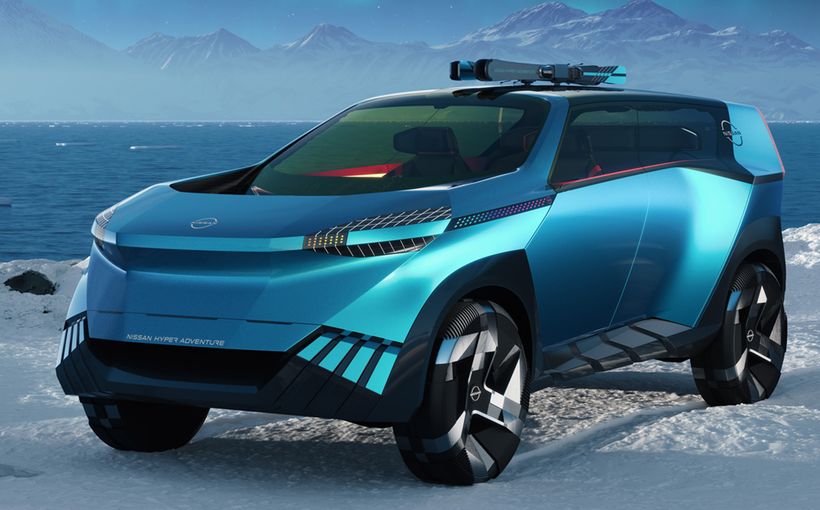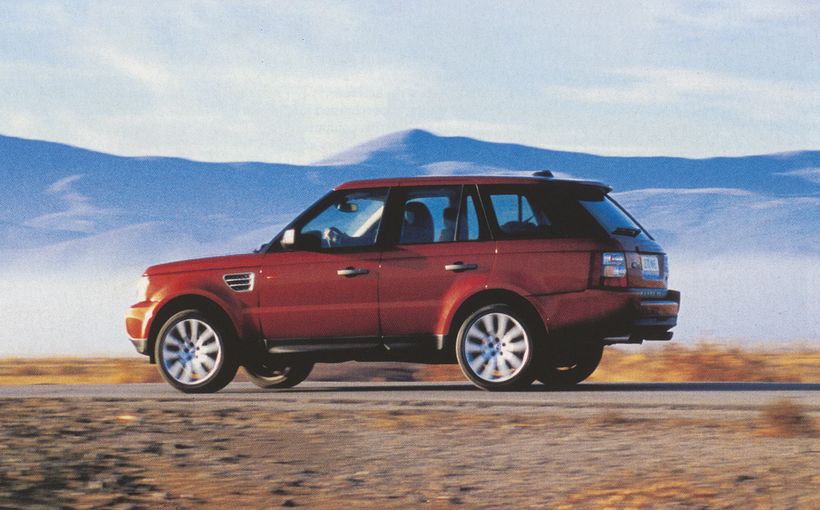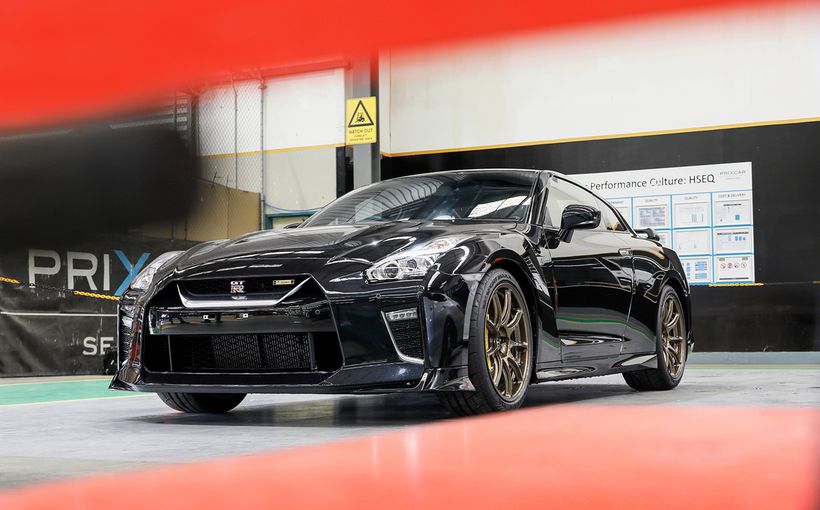Nissan GT-R: Numbers of the Beast

WORDS JESSE TAYLOR PHOTOS SPLIT IMAGE
GODZILLA is back! And without resorting to hyperbole, it's fair to say that the Nissan GT-R is the most anticipated car of 2007. While you let that bold statement sink in, remember that this calendar year has seen the release of the Porsche 911 GT2, Ferrari 430 Scuderia, BMW MB, Subaru WRX STi, Mitsubishi Lancer Evo X and Audi's ground-breaking R8 supercar.
Without doubt, Godzilla, like its Tokyo-destroying namesake, is bigger than them all.
And if you're reading this on Wednesday 24 October, you're one of the first in the world to see official photos of the GT-R. Thanks to a little help from the International Dateline, Wheels is the first magazine in the world to publish undisguised photos and information on Nissan's new supercar. So without delay, here are the headline facts you're desperate to know.
The Skyline tag has been dropped, and the latest generation R35 GT-R is powered by a 3.8-litre twin- turbocharged V6, producing 348k W at 6400rpm and 588Nm from 3200-5200rpm. Drive is taken to all four wheels via a six-speed dual-clutch sequential manual transmission - there are no plans for a regular H-pattern manual. And, yes, Nissan Australia is bringing GT-R back to Australia.
As Wheels closed for press in early October, Nissan Australia managing director Shinya Hannya confirmed what we've all been hoping. "The GT-R attained legendary status in Australia during the early '90s and the new GT-R will continue to build on this legend," said Mr Hannya. No further details on timing or pricing were forthcoming, but our best guess is that GT-R will hit Nissan showrooms in limited numbers by early 2009. As for price, we'd estimate that GT-R will command a sticker of around $160,000. Yes, that's a lot of money for a car that will share the showroom with Tiidas and Patrols, but a bargain for Porsche 911 Turbo performance - a car Nissan has made no secret of benchmarking the GT-R against during its development phase.

The hype surrounding the GT-R has given it legendary status even before it has turned a wheel in anger. Developed under a cloak of almost paranoid secrecy at the Nissan Technical Centre in Atsugi, the GT-R had a dedicated test team for duties at the Nürburgring in Germany, and Sears Point and Laguna Seca in the USA. For those involved in the GT-R project, it's been a once- in-a-lifetime experience with the freedom of money not really being an object, but with enormous internal and external pressure to deliver something astonishing. Nissan President Carlos Ghosn took an enormous personal interest in the project from the very beginning, and now it's complete, it's a huge source of pride for him.
And even though Wheels was granted access to photograph (but not drive) the GT-R at Nissan's Hokkaido Rikubetsu proving ground months before its big reveal, no official data was handed out before the Tokyo Motor Show unveiling on the 24 October. Therefore, the information presented here, while not official, comes from sources within Nissan in Japan and Europe. Full official specifications are now available online at www.wheelsmag.com.au.
At the heart of the beast is a brand-new 3.8-litre 60-degree V6, Wearing the designation VR38DETT, the twin-turbocharged engine is unique to GT-R, and very distinct from the VQHR series of engines that power Nissan's 350Z and Skyline models. However, it should be noted that architecturally, there is some crossover with the 350Z's 230kW naturally aspirated V6 - both use a 95.5mm bore. At 88.4mm, however, the GT-R's stroke is 7mm longer than that of the 350Z and accounts for the extra 301cc of swept capacity.

Once details of the VR engine code began to leak onto enthusiasts websites, speculation began that the GT-R's engine was related to the VRH35L twin-turbo V8 used in the 1997-‘98 Nissan R390 Le Mans racer (and road car). However, insiders at Nissan say that while the Le Mans project taught the engineers plenty of lessons, the GT-R's VR38DETT is a genuine clean-sheet design. And while Nissan denies any official link, it's interesting to note that the chief engineer on the Le Mans project and the new GT-R is Kazutoshi Mizuno (who replaces R32-R34 GTR guru Kozo Watanabe).
The V6 uses aluminium for the cast block and heads, with lightweight magnesium cam covers, timing chain cover and oil pan. The inlet and exhaust valves are made of titanium, and the timing of both is continuously variable thanks to the latest generation of Nissan's Variable Valve Event and Lift (VVEL) system. The individual tuned-length intake runners, visible through a neat cut-out, are made from aluminium.
Below decks, the VR38DETT uses titanium conrods, with forged pistons giving a 9.0:1 static compression ratio. With a sizeable capacity and a relatively high squeeze ratio, the GT-R should deliver impressive off-boost throttle response.
But the real fireworks begin when the twin low-inertia turbos start blowing 0.7bar of boost. All 588Nm is thumping from 3200rpm and continues to hammer across a torque mesa until 5200rpm. Power peaks with 348kW delivered at a lowish 6400 revs, but the engine keeps spinning until 7500pm with a 7000rpm redline. Around 90 percent of peak power is still available at redline.

Purists may moan that GT-R is not available with a traditional manual gearbox, but dual-clutch transmissions are the way of the future. Manufactured by Aichi-Kikai (a Nissan subsidiary) the six -speed, dual-clutch, rear mounted transaxle (code-named GR6) operates in automatic or manual modes: with manual shifts executed via steering column-mounted paddles.
Drive is taken from the back of the engine to the transaxle via a carbonfibre torque tube. A second, steel prop-shaft then re-directs drive to the front wheels. Nissan claims the transaxle is "soft-mounted" to the body to avoid engine movements effecting the rear suspension geometry under hard acceleration - the engineers call the system an "independent transaxle". This transaxle layout aids weight distribution, but GT-R still comes in nose-heavy at 58:42.
The ATTESA E-TS all-wheel-drive system (it stands for Advanced Total Traction Engineering System for All Electronic Torque Split) is an evolution of that used in the R32-R34 generations of the Skyline GT-R. It features a new Yaw Rate Feedback control which reacts faster to wheel slip, and can alter torque front-to-rear as well as side-to-side. Until wheel slip is detected, 100 percent of the torque is fired to the rear wheels, with a maximum of 50 percent of torque shuffled forward when the rears start spinning. Sophisticated traction control and ESP is also part of the ATTESA electronics suite.

The big shock for GT-R, however, is that four-wheel steering (4WS) has been ditched. A staple of the previous three generations of all-wheel-drive GT-R, 4WS didn't made the cut this time because chief engineer Mizuno thinks it adds unnecessary complexity and weight - in a car that's already stuffed with technology and complexity. But Mizuno's final argument was a simple one: "no racing car has 4WS."
Like V36 Skyline, the new GT-R runs a double A-arm front suspension with coil springs and anti-roll bar, with a multi-link rear end. Big Brembo brakes hang off alloy hubs at each corner. Nissan has shunned trendy composite brakes discs for now, opting for cast-iron rotors squeezed by six-piston monoblock calipers up front, four piston rears. Composites discs are a likely option in the future, or as standard equipment on a future V-spec GT-R.
Like the drivetrain, GT-R's architecture is unique in the Nissan world. Dubbed Premium Midship (first reported in the April 2007 issue of Wheels), the platform is a step up from the Front Midship platform employed by the 350Z and V36 Skyline. Made from steel, the chassis is clothed with aluminium boot, bonnet and doors. Carbonfibre is used for the front guards and inside the engine bay.

The chunky styling, by Hiroshi Hasegawa, is best described as ruggedly handsome, and does nothing to hide the GT-R's massive physical presence. At 4655mm in total length, it's 205mm longer than a Porsche 911 Turbo, and its 1895mm width is 43mm broader than the iconic Porker, and just 5mm slimmer than Lamborghini's fat-hipped Gallardo. On a 2780mm wheelbase, the big Nissan is 430mm longer between the axles than a 911, so rear seat space is bordering on useable for adults (unlike the 911). CT-R's 1370mm height is 70mm taller than a 911, and its hefty 1740kg kerb weight is 155kg more than the Turbo.
As such, the Nissan's 200kW-per-tonne power-to-weight ratio is no match for the 223k W/tonne of the Stuttgart stormer. And with 620Nm, the 911 Turbo out-grunts the GT-R by 32Nm. But none of this matters at the Nürburgring, where the GT-R unofficially stormed the 20.8km Nordschleife in 7 minutes 37 seconds - undercutting the 911 Turbo by three seconds. And insiders at Nissan are at pains to mention three sections of the fabled circuit were damp when this time was set in late September. The same insiders talk confidently of 7:30 in perfect conditions, Given the anticipation lumped on Godzilla's broad shoulders, expect Nissan to keep trying until the number is official.

Three levels of GT-R will be available in the domestic market - Base, Black and Premium - and all wear 20-inch alloys. Base and Black GT-Rs get silver alloys shrink- wrapped in 255/40ZRF20 Dunlops up front and supercar-fat 285/35ZRF20 under the rump. Premium GT-Rs (pictured) feature a gunmetal grey version of the same wheels but with stickier Bridgestone RE070R tyres.
Both the Dunlops and Bridgestones are run-flat tyres.
In Japan, the GT-R kicks off at the equivalent of just $75,000 and tops out at around $82,000 for the Premium model. Only six colours will be available, with black, red, and titanium grey the standard hues. Pearl white adds a 30,000yen premium (around $300), and dark grey metallic will be limited to only 40 cars per month. The hero colour of the range is Ultimate Metal Silver (pictured) which, in Japan, costs an extra $3000.
In the domestic market, all three grades get only dual front airbags, with the option of side bags - expect these to be standard on Australian-bound cars. Premium edition GT-Rs get heated front seats and high-end Bose audio systems.
Now that Nissan has finally released photos and details of the new Godzilla, there's only one question left to be answered, How does it drive? Wheels will bring you the answer in our January issue (on sale December 20, 2007) when we unleash the new GTR at the Nürburgring in an exclusive first drive.

Protect your Classic. Call Shannons Insurance on 13 46 46 to get a quote today.








